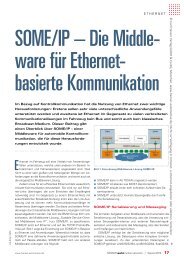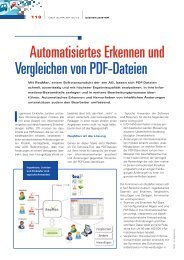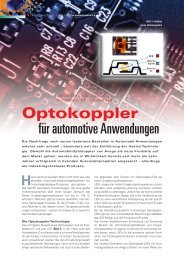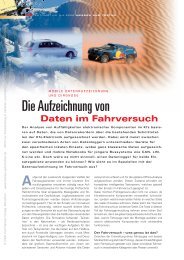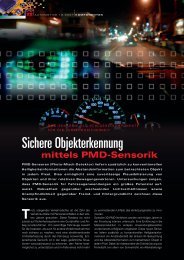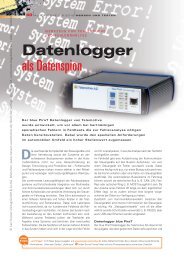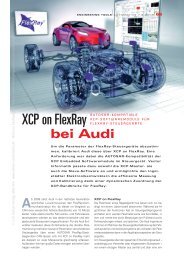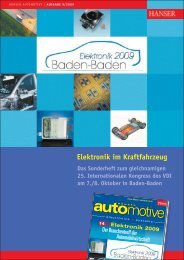Download - HANSER automotive
Download - HANSER automotive
Download - HANSER automotive
You also want an ePaper? Increase the reach of your titles
YUMPU automatically turns print PDFs into web optimized ePapers that Google loves.
© Carl Hanser Verlag, München www.hanser-<strong>automotive</strong>.de Nicht zur Verfügung im Intranet- und Internet-Angeboten sowie elektronischen Verteilern<br />
12lA UTOMOTIVE 2008l SPECIAL EDITION FLEXRAY<br />
transferred to MATLAB/Simulink, where the data is used<br />
as parameters for FlexRay communication blocks from the<br />
RTI FlexRay Configuration Blockset. Application-specific<br />
Simulink models can be created using the RTI FlexRay Configuration<br />
Blockset as a basis, with data provided by the<br />
configuration tool. The block attributes are filled with data<br />
generated by the dSPACE FlexRay Configuration Tool. The<br />
blockset contains additional blocks that can be used for<br />
task execution control, interrupt and error handling, status<br />
information, and controller reset. The hardware is connected<br />
via the FlexRay interface to the FlexRay bus, and from<br />
there to the FlexRay ECUs which are the units under test.<br />
The FlexRay Configuration Package is not<br />
only concerned with simple restbus<br />
simulation for mimicking the network<br />
behavior, but also allows target-oriented<br />
failure simulation by checking potential<br />
failure cases. For example, the package<br />
can be used to insert logical corruptions<br />
in FlexRay communication to allow a<br />
cyclic FlexRay frame to be switched in or<br />
out, CRC algorithms to be switched<br />
during run time, etc.<br />
In addition, it is also possible to have a failure<br />
insertion on the physical level by<br />
simulating broken wires, short circuits,<br />
etc., or to vary the termination resistance.<br />
This can be done with suitable failure<br />
insertion hardware for differential<br />
busses.<br />
The dSPACE FlexRay Configuration Tool<br />
can create several kinds of time-triggered<br />
tasks for the various scenarios. In addition<br />
to these test functions for FlexRay<br />
networks, the tool can also be used in<br />
connection with the RTI Bypass Blockset<br />
and the Universal Measurement and<br />
Calibration Protocol (XCP). XCP is the successor to the<br />
much-used CAN Calibration Protocol (CCP). The advantage<br />
of XCP is that it provides strict separation between the protocol<br />
and the transport level, and is therefore open for the<br />
implementation of FlexRay or even future bus systems.<br />
XCP on FlexRay is part of the XCP family standardized by<br />
ASAM. The XCP concept is based on the master/slave principle,<br />
with the electronic control unit (ECU) as the slave.<br />
XCP on FlexRay is already being used in numerous projects,<br />
especially where the CAN bus has been replaced by<br />
FlexRay.<br />
Task-Synchronous Bypassing via XCP<br />
on FlexRay<br />
Due to the complexity of modern electronic control units<br />
(ECUs) and the limited time available for the development<br />
of new ECU generations, the entire ECU software is developed<br />
from scratch in only very few cases. Instead the existing<br />
ECU code is adapted or extended. The external<br />
bypass method is an efficient approach in this context, allowing<br />
new algorithms to be developed on a rapid prototyping<br />
system while the original ECU executes all the functions<br />
that remain unchanged. The input and output variables<br />
of the bypass model are exchanged, and task execution<br />
on the ECU and the prototyping system is synchronized<br />
via existing ECU interfaces such as XCP on FlexRay.<br />
The external bypass approach gives the greatest flexibility<br />
possible during the design phase, since there are almost<br />
no resource constraints such as RAM, ROM, processor<br />
performance, or I/O channels. Real-time behavior is guaranteed<br />
even for complex bypass functions. In addition, the<br />
autoboot options of the prototyping systems allow the<br />
behavior of new functions to be validated in realistic scenarios,<br />
for example during test drives.<br />
Fig. 1: Workflow with dSPACE’s FlexRay solution.<br />
© <strong>automotive</strong><br />
In this configuration example, the dSPACE MicroAutoBox<br />
is used as a real-time prototyping system. The bypass function<br />
is calculated synchronously to an ECU task. As soon<br />
as all the input data of the bypass model is available, an<br />
interrupt is triggered and the bypass task on the MicroAutoBox<br />
is executed. Alternatively, task execution on the two<br />
systems can be synchronized by means of the FlexRay<br />
message schedule. Execution of the bypass task is then<br />
purely time-driven (Fig. 2).<br />
Real-Time ECU Access via XCP on Flex-<br />
Ray<br />
For developing ECU functions by means of the external<br />
bypass approach, it is usually necessary to configure the<br />
bypass interface in the modeling environment and to change<br />
the input and output signals of the bypass model<br />
without ECU code modifications. The RTI Bypass Blockset<br />
provides a generic user interface for this purpose, with the<br />
same look and feel no matter what ECU interface is actually<br />
used for bypassing.<br />
The XCP on FlexRay option of the RTI Bypass Blockset is<br />
based on the dSPACE FlexRay Configuration Package. The



